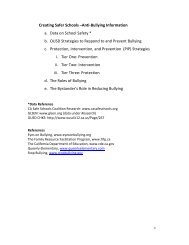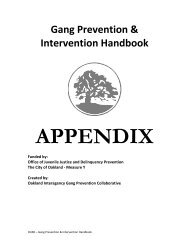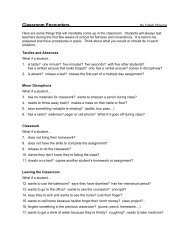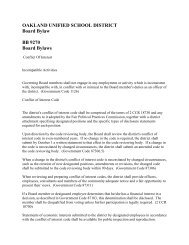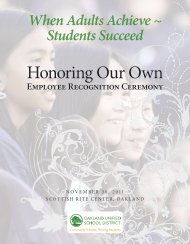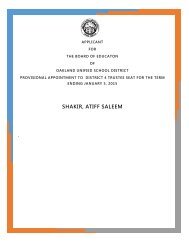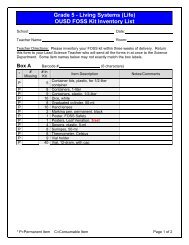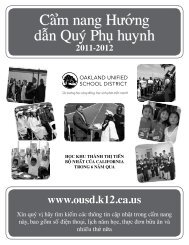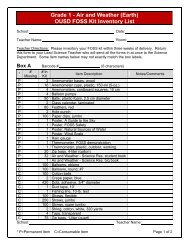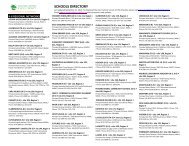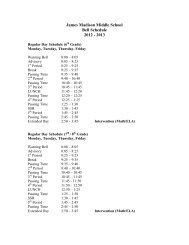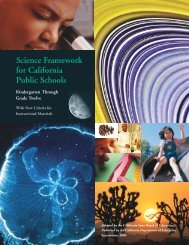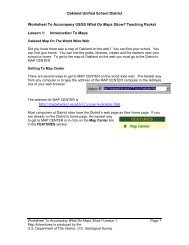Oakland Unified School District Case Study
Oakland Unified School District Case Study
Oakland Unified School District Case Study
Create successful ePaper yourself
Turn your PDF publications into a flip-book with our unique Google optimized e-Paper software.
<strong>Oakland</strong> <strong>Unified</strong> <strong>School</strong> <strong>District</strong><br />
<strong>Case</strong> <strong>Study</strong><br />
ACORN Woodland Elementary<br />
Kenneth Montgomery<br />
The <strong>School</strong> Redesign Network at Stanford University
This case study is one of six conducted for the report, <strong>Oakland</strong> <strong>Unified</strong> <strong>School</strong> <strong>District</strong>:<br />
New Small <strong>School</strong>s Initiative Evaluation. The report and case studies can be downloaded<br />
from http://www.srnleads.org/resources/publications/ousd/ousd.html.<br />
This study was conducted by the <strong>School</strong> Redesign Network at Stanford University.<br />
© 2009 <strong>School</strong> Redesign Network. All rights reserved.<br />
Citation: Montgomery, K. (2009). <strong>Oakland</strong> <strong>Unified</strong> <strong>School</strong> <strong>District</strong> case study: ACORN<br />
Woodland Elementary. Stanford, CA: <strong>School</strong> Redesign Network at Stanford University.<br />
The <strong>School</strong> Redesign Network at<br />
Stanford University engages in research<br />
and development to support districts and<br />
schools that are equitable and enable all<br />
students to master the knowledge and skills<br />
needed for success in college, careers, and<br />
citizenship.<br />
Linda Darling-Hammond, Founding Director<br />
Raymond Pecheone, Co-Executive Director<br />
Ash Vasudeva, Co-Executive Director<br />
505 Lasuen Mall<br />
Stanford, CA 94305-3084<br />
650.725.0703<br />
srnleads.org<br />
<strong>Oakland</strong> <strong>Unified</strong> <strong>School</strong> <strong>District</strong><br />
operates with the goals of universal college<br />
and workplace readiness, quality public<br />
schools in every neighborhood, clean<br />
and safe learning environments, service<br />
excellence across the district, and equitable<br />
outcomes for all students.<br />
Roberta Mayor, Interim Superintendent<br />
1025 Second Avenue<br />
<strong>Oakland</strong>, CA 94606-2212<br />
www.ousd.k12.ca.us<br />
510.879.8242<br />
SRN LEADS<br />
S T A N F O R D U N I V E R S I T Y<br />
OAKLAND UNIFIED<br />
SCHOOL DISTRICT<br />
expect Success<br />
Cover photo: Courtesy of ACORN Woodland Elementary
Photo: Courtesy of ACORN Woodland Elementary
Introduction<br />
ACORN Woodland Elementary (AWE) represents one of the most remarkable academic<br />
turnarounds of any school in the state of California. In 2000-01, its first<br />
year open, AWE scored a 345 on California’s Academic Performance Index (API) 1<br />
making it one of the lowest scoring elementary schools in the state and the lowest<br />
performing elementary school in <strong>Oakland</strong> <strong>Unified</strong> <strong>School</strong> <strong>District</strong> (OUSD). In 2007-08,<br />
AWE bested its initial score by over 400 points, earning an API of 774 2 . AWE is unique not<br />
only for its spectacular API growth, but as one of the first new small schools in OUSD, it<br />
provides a unique perspective into the history of the district’s new small schools initiative.<br />
AWE showcases the important community role in launching and supporting a school, and<br />
demonstrates the promise of “re-incubation” as a strategy for helping schools to overcome<br />
tremendous challenges and to “re-vision” themselves for long-term academic success.<br />
Section One of the case study describes<br />
AWE’s academic trajectory and development<br />
story, highlighting the school’s steep<br />
ascent on the California API: from 345 in<br />
2001 to 774 in 2008. After leadership challenges<br />
plagued the school’s first year of operation,<br />
subsequent academic gains reflect<br />
strong school leadership, stable principal<br />
transitions, and a “re-incubation” process<br />
that helped staff build on, extend, and<br />
supplement the school’s literacy curricula to<br />
improve student achievement.<br />
Section Two of the case study describes<br />
four critical attributes of a school’s academic<br />
functioning: the school learning climate,<br />
instructional program, professional capacity,<br />
and parent and community relations.<br />
By discussing these four attributes and the<br />
district policy supports that contributed to<br />
their development, the case study is designed<br />
to inform, improve, and strengthen<br />
understanding and connections between<br />
OUSD’s central office and local schools.<br />
This section focuses on AWE’s efforts to<br />
develop and reinforce a positive learning<br />
climate by regularly celebrating students’<br />
academic success and to create a coherent<br />
instructional program that supplements district<br />
curricula to meet the needs of diverse<br />
learners. These modifications include, for<br />
example, active-learning strategies such as<br />
“reading buddies” (older students reading<br />
to younger students), and using locally<br />
developed benchmark assessments to<br />
monitor student progress. 3 AWE has further<br />
strengthened its instructional program<br />
through an extended learning program that<br />
ends at 6:00 p.m. each day.<br />
Its investment in teachers has played a<br />
critical role in the school’s success. Using<br />
the autonomy provided by Results-<br />
Based Budgeting, 4 AWE’s principal has<br />
made sustained investments in coaching<br />
and teacher collaboration time. These<br />
investments, combined with refined<br />
teacher-hiring practices that include panel<br />
interviews, demonstration lessons, and<br />
writing samples, have helped strengthen<br />
AWE’s professional capacity.<br />
Community support and involvement<br />
inspired AWE’s inception, and the school<br />
continues to be seen as a sanctuary in an economically<br />
depressed neighborhood. While<br />
parent and community leaders remain<br />
key supporters of the school, AWE is now<br />
focused on finding ways to engage them<br />
in ways that support students’ academic<br />
achievement.<br />
OUSD <strong>Case</strong> <strong>Study</strong>: ACORN Woodland Elementary 1
A<br />
Section One: AWE’s Academic Trajectory<br />
and Development Story<br />
CORN Woodland Elementary has consistently improved student outcomes on state<br />
tests in each year of its operation, although it started near the bottom. Improvements<br />
over this time span are represented in Figure 1, below. The trends indicate<br />
that AWE experienced a large portion of its academic growth during its first 4<br />
years as it rose from the bottom of the scale, with more moderate but substantial growth<br />
over the past 4 years. 5<br />
AWE has achieved these gains while<br />
maintaining relatively similar demographics<br />
(see Table 1, page 3). AWE currently has<br />
a waiting list for student enrollment,<br />
and although some students come to<br />
AWE from outside the Elmhurst area,<br />
according to school officials the majority<br />
of students continue to come from the<br />
local neighborhood. Therefore the shift in<br />
school demographics mirrors the changes<br />
in community demographics. Over the<br />
past eight years, the neighborhood served<br />
by AWE has shifted from predominantly<br />
African-American to Latino, and AWE’s<br />
recent enrollment trends reflect this<br />
change.<br />
The most striking feature when looking<br />
at enrollment and API trends is the sharp<br />
increase in the percent of English language<br />
learners in the 2007-08 school year, the<br />
same year in which AWE earned its high-<br />
900<br />
800<br />
700<br />
600<br />
500<br />
API 400<br />
300<br />
200<br />
100<br />
0<br />
345 392 509<br />
2001 2002 2003 2004<br />
2001<br />
2002<br />
AWE API<br />
FIGURE 1: AWE API<br />
(re-incubation) 2005<br />
Year<br />
Source: http://api.cde.ca.gov/<br />
2003<br />
2004<br />
(change implemented) 2005<br />
608 661 657 688 774<br />
2006 2007 2008<br />
2006<br />
2007<br />
2008<br />
API<br />
Score<br />
2<br />
<strong>School</strong> Redesign Network at Stanford University
Table 1: AWE Enrollment Trends<br />
Year<br />
<strong>School</strong> Size<br />
% African<br />
American<br />
% Latino<br />
% English<br />
language<br />
learner<br />
% Free and<br />
reduced<br />
lunch<br />
2007-08 246 19% 75% 70% 91%<br />
2006-07 250 17% 75% 60% 92%<br />
2005-06 258 22% 71% 56% 77%<br />
2004-05 241 25% 71% 57% n/a<br />
2003-04 251 28% 69% 60% 87%<br />
Source: http://data1.cde.ca.gov/dataquest/ accessed 11-18-2008<br />
est API score. Given that the California<br />
Standards Tests (CST) are in English,<br />
AWE’s growth is even more notable. Many<br />
school leaders attribute this recent increase<br />
in scores to changes in the school’s curriculum,<br />
assessments, and instructional<br />
practices.<br />
As a result of the somewhat flat scores<br />
over the preceding 3 years, school<br />
leaders had made important changes<br />
in their instructional program aimed at<br />
reaching their goal of an 800 API score.<br />
One important change in 2007-08 was<br />
the development of interim assessments<br />
for English language arts (ELA) based<br />
on the New Leaders for New <strong>School</strong>s 6<br />
assessments. The interim assessments in<br />
ELA were also more closely aligned to<br />
the CST providing teachers better data<br />
on areas where student learning is strong,<br />
areas where students are struggling, and<br />
areas where more or different classroom<br />
instruction may be needed. Specifically,<br />
the ELA interim assessment results<br />
showed that students were not receiving<br />
enough active learning opportunities<br />
to independently understand what they<br />
were reading. This information pointed<br />
the teachers toward making changes<br />
in their classroom teaching practice as<br />
the year progressed that fostered student<br />
engagement.<br />
Another important change was the implementation<br />
of the Si Swun math program. 7<br />
The Si Swun math program provided the<br />
school with assessments better aligned to<br />
the end-of-year CST in math, and was more<br />
closely aligned to the school’s active learning<br />
philosophy. Both Si Swun and the New<br />
Leaders assessments are key components of<br />
the district’s move toward standards-based<br />
classroom assessments, as 20 schools will<br />
implement the Si Swun program in 2008-<br />
09, and 11 schools piloted the New Leaders<br />
assessments in 2007-08. The initial scores<br />
on the ELA and math assessments show<br />
students making significant progress over<br />
the course of the year (see Figures 1 and 2,<br />
page 4).<br />
The 2008-09 school year is the first year<br />
that these assessments were used at the<br />
school, and the final administration of the<br />
tests correlated almost exactly with the CST<br />
scores. On the ELA assessment, 43% of<br />
students were proficient or advanced, compared<br />
to 44% on the CST; on the Si Swun<br />
math assessment, 67% were proficient or<br />
advanced compared to 65% on the CST<br />
math test.<br />
OUSD <strong>Case</strong> <strong>Study</strong>: ACORN Woodland Elementary 3
FIGURE 1: AWE SI SWUM MATH<br />
ASSESSMENT RESULTS, 2007-08<br />
FIGURE 1: AWE ELA INTERIM<br />
ASSESSMENT COMPARISON, 2007-08<br />
40<br />
35<br />
30<br />
25<br />
20<br />
15<br />
10<br />
5<br />
0<br />
AWE Si Swun Math Assessment Results<br />
2007-08<br />
29<br />
27<br />
26<br />
Tri 2 Tri 3<br />
38<br />
30<br />
19<br />
% Not Proficient<br />
% Proficient<br />
% Advanced<br />
80<br />
70<br />
60<br />
50<br />
40<br />
30<br />
20<br />
10<br />
0<br />
70<br />
7<br />
AWE ELA Interim<br />
Assessment Comparison<br />
2007-08<br />
51<br />
18<br />
43<br />
40 38<br />
29<br />
IA 1 IA 2 Mid-Year IA 4<br />
Interim Assessment<br />
% Below<br />
Benchmark<br />
% At/Above<br />
Benchmark<br />
Source (both figures): AWE internal document. The results do not add up to 100% because the graphs do<br />
not include the number of students who fell into the category of “approaching” or “partial” proficient,<br />
given that API scores will be based only on proficient or not proficient.<br />
Underlying AWE’s impressive academic trajectory<br />
is a development story that features<br />
initial struggle and conflict, followed by<br />
rebirth and success. Opened as then-superintendent<br />
Dennis Chaconas’s pilot small<br />
school, before the OUSD board officially<br />
passed the New Small Autonomous <strong>School</strong>s<br />
district policy, AWE has a unique history in<br />
the district’s pantheon of small schools. In<br />
particular, AWE’s development shows that<br />
it is possible to improve a struggling school<br />
through strong leadership and a re-visioning<br />
process that, in this case, yielded a more<br />
coherent instructional program and a commitment<br />
to investing in quality teaching.<br />
Members of the East <strong>Oakland</strong> community<br />
consider AWE’s opening an important<br />
achievement for their neighborhood.<br />
In the late 1990’s, the community was<br />
unhealthy for families. According to an<br />
ACORN community leader, 9 the surrounding<br />
area “was in blight, it was referred to<br />
as dope haven, drug haven, or prostitution<br />
haven.” ACORN community leaders<br />
wanted to begin restoring their neighborhood,<br />
and identified a vacant site to begin<br />
the revitalization process. They initiated<br />
a door-knocking campaign to see what<br />
the community wanted on the site, and<br />
after numerous home visits and community<br />
meetings, it was agreed upon that site<br />
should house a new school.<br />
The group continued meeting with parents,<br />
culminating in a forum at Castlemont High<br />
<strong>School</strong> that drew school board members,<br />
the school district superintendent, City<br />
Parks and Recreation officials, and<br />
members of the <strong>Oakland</strong> City Council to<br />
determine the necessary steps for building<br />
a school on the vacant site. Approval<br />
was granted for the school, pending the<br />
passage of a bond measure for purchasing<br />
the property. After this bond measure was<br />
passed in 1999, the City Council used the<br />
process of eminent domain (the state’s right<br />
to take over private property for public<br />
4<br />
<strong>School</strong> Redesign Network at Stanford University
use) to garner additional property for the<br />
school.<br />
Securing the resources to build a school was<br />
an important achievement for community<br />
residents. As a school administrator commented,<br />
“This community has been historically<br />
underserved compared to the Fruitvale<br />
community. There are no open spaces or<br />
community centers here. It’s liquor stores<br />
and churches.” Generating the commitment<br />
and resources to build a new school in this<br />
part of East <strong>Oakland</strong> was a critical lever for<br />
developing the community’s resources.<br />
In addition to playing a key role in securing<br />
capital for the school, ACORN also<br />
played an instrumental role in the design of<br />
the school. ACORN members worked with<br />
staff members from the Bay Area Coalition<br />
for Equitable <strong>School</strong>s (BayCES) and met<br />
with teachers and administrators to decide<br />
school governance, curriculum, and community<br />
connections. Despite this advance<br />
work, the project was stalled until Dennis<br />
Chacones was hired as superintendent in<br />
2000. Upon his hire, he agreed to work<br />
with the group to push the school forward.<br />
The group targeted September 2000 for the<br />
opening of the new school. The date was<br />
met with some resistance by the district,<br />
but amidst pressure from the community,<br />
Chacones visited the school site in the summer<br />
of 2000 and, according to one parent,<br />
“took off his suit, got in his jeans and tennis<br />
shoes, began working and opened the<br />
school in portables in September 2000.”<br />
Despite all the energy put into the founding<br />
of AWE, the first few years of operation<br />
were fraught with problems. The<br />
school was designated by Chacones as<br />
one of several schools piloting the Open<br />
Court elementary reading and literacy<br />
curriculum, but many teachers and community<br />
members were more interested in<br />
a focus on social justice. In practice, the<br />
competing visions resulted in the school<br />
effectively implementing neither the Open<br />
Court Reading (OCR) program nor a social<br />
justice program. According to one district<br />
leader, the school had difficulty implementing<br />
the Open Court curriculum because the<br />
school was given the curriculum and materials<br />
at the start of the school year without<br />
any professional development for teachers<br />
regarding its use. The school struggled<br />
implementing the social justice program<br />
because, according to one founding teacher,<br />
there was never a clear vision of what social<br />
justice looked like in practice in the classroom.<br />
Then teacher and now principal,<br />
Kimi Kean, reflected on the problems faced<br />
during the school’s first year:<br />
[There was] lots of turmoil and no<br />
coherent vision. Everyone wanted<br />
to lead the school in a different way.<br />
There were lots of conflicts and<br />
many people left at the beginning.<br />
We started K-5, and the fifth graders<br />
were kids that were underserved for<br />
6 years. The kids were off the hook.<br />
In addition to being under-prepared to<br />
implement the Open Court curriculum or<br />
a social justice program, much of the incoherence<br />
was attributed the disagreements<br />
among staff and school leadership. The<br />
founding principal — who was selected<br />
by the superintendent and was new to the<br />
principalship as well as to the community<br />
— clashed with faculty over the direction of<br />
the school, and at the conclusion of AWE’s<br />
first year, it emerged as the lowest performing<br />
elementary school in the city. 10 According<br />
to one school official, “All the energy<br />
around change did not produce increases<br />
in achievement.” Insufficient professional<br />
development for teachers, combined with<br />
OUSD <strong>Case</strong> <strong>Study</strong>: ACORN Woodland Elementary 5
competing visions, created considerable upheaval,<br />
which the first principal was unable to<br />
overcome.<br />
The school’s second principal, Helen Duffy,<br />
was an experienced principal from the San<br />
Francisco <strong>Unified</strong> <strong>School</strong> <strong>District</strong> and had<br />
worked with ACORN, although she was<br />
new to this East <strong>Oakland</strong> neighborhood. She<br />
brought stability to AWE and mentored Kean<br />
over the next 4 years. In 2004, Duffy announced<br />
her pending retirement and agreed<br />
to stay until Kean finished her administrative<br />
certification program. Kean received a fellowship<br />
to participate in the New Leaders for<br />
New <strong>School</strong>s certification program, which<br />
she credits as playing an essential role in her<br />
development as principal. After her residency<br />
year in 2004-05, she assumed the principalship<br />
for the 2005-06 school year, with the<br />
promise of three more years of leadership<br />
support and coaching from New Leaders for<br />
New <strong>School</strong>s.<br />
The story of Kean’s rise to the principalship<br />
is widely known throughout the school. Kean<br />
grew up in <strong>Oakland</strong> and dropped out of Skyline<br />
High <strong>School</strong> at age 15. After a few years<br />
of renting an apartment with friends and<br />
working at a delicatessen, she completed her<br />
high school equivalency diploma and enrolled<br />
at Laney Community College. She transferred<br />
to the University of California, Berkeley, and<br />
later earned her master’s degree and teaching<br />
certificate at Columbia University’s Teachers<br />
College. After working as a student teacher at<br />
a school in New York that had converted to a<br />
small school, Kean returned to <strong>Oakland</strong> as a<br />
first-year teacher at ACORN Woodland<br />
Elementary 11 . Prior to naming Kean principal,<br />
Helen Duffy created a coaching position<br />
that allowed Kean to visit different schools<br />
and look at the different programs throughout<br />
the district. This process informed Kean’s<br />
subsequent decision to pursue a school revisioning<br />
process (to create a new vision,<br />
mission, and theory of action for the whole<br />
school), focused primarily on developing<br />
the school’s instructional program.<br />
Academic issues, accompanied by a troublesome<br />
school climate, sparked the decision<br />
to place the school on a path toward reincubation.<br />
In 2004-05, Kean was allowed<br />
to join the district’s new school incubator<br />
program, and led the school through the revisioning<br />
process. She described the OUSD<br />
incubator as “what should happen to all<br />
schools first.”<br />
The program was built on a 12-part curriculum<br />
designed by the OUSD New <strong>School</strong><br />
Development Group. The process began by<br />
forming a community-based design team,<br />
creating a school vision and culture, and<br />
then developing a strategy for improving<br />
student outcomes. After those areas had<br />
been addressed, the design team of teachers<br />
and parents worked on developing an<br />
aligned instructional program and implementation<br />
plan. As part of the reincubation,<br />
Kean toured other schools with AWE<br />
family members, and these observers began<br />
to generate a list of ideas they saw at other<br />
schools that they wanted implemented at<br />
AWE. Kean also wrote grants that brought<br />
in approximately $200,000 in additional<br />
funding to provide coaches for leaders and<br />
staff to guide them as they underwent the<br />
change process. Kean sees the re-visioning<br />
process as supporting the school in developing<br />
four key areas: the school’s instructional<br />
program, its academic goals for students,<br />
its school culture, and its vision for family<br />
partnerships. According to Kean, the school<br />
is beginning to see progress in achieving its<br />
vision in each of these respective areas. She<br />
says, “After 3 years, I see substantial evidence<br />
that we are realizing what we set out<br />
to do.”<br />
6<br />
<strong>School</strong> Redesign Network at Stanford University
Photo: Courtesy of ACORN Woodland Elementary<br />
Section Two:<br />
Academic Functioning and Supports<br />
SCHOOL LEARNING CLIMATE<br />
Even before stepping onto the campus of ACORN Woodland Elementary, one is<br />
struck by the contrast between the school and its surroundings. Situated between a<br />
weed- and debris-infested vacant lot and a cookie factory, the AWE campus is often<br />
referred to as a sanctuary in the community. The two-story, $22 million facility it<br />
shares with EnCompass Academy is nearly 4 years old, but still looks brand new. Students<br />
and staff move throughout the campus with a sense of purpose that affirms and reflects<br />
the school’s vision of helping young scholars reach their full potential through dedication,<br />
high expectations, and excellent teaching.<br />
After its tumultuous beginning, AWE has<br />
made much progress in creating and supporting<br />
an academically focused school<br />
climate. Much of the strides made in improving<br />
the school learning climate are attributed<br />
to small school size and the staff’s<br />
OUSD <strong>Case</strong> <strong>Study</strong>: ACORN Woodland Elementary 7
elentless attention to college readiness,<br />
public celebrations of academic achievement,<br />
and strong parent-community relationships.<br />
All students are expected to leave AWE<br />
with the skills and determination to successfully<br />
pursue a college education, and it<br />
is apparent that AWE staff members have<br />
worked diligently to use meaningful symbols<br />
and events to create a school climate<br />
focused on achieving this goal. For example,<br />
the staff make it a point to refer to<br />
their students as “scholars.” These scholars<br />
attend classes named after universities and<br />
constantly celebrate their academic achievements.<br />
The hallways are filled with examples<br />
of student work and pictures of students<br />
who have achieved high levels or who<br />
have made significant progress in improving<br />
their scores on the school’s interim assessments<br />
in math and language arts.<br />
Public celebration of academic success is<br />
also the focal point of the school’s culture:<br />
AWE builds its academic learning climate<br />
by regularly convening members of the<br />
school community to recognize academic<br />
success in the weekly culture assembly.<br />
During one assembly, students, dressed in<br />
their school uniforms, gathered outside in<br />
the amphitheatre for announcements and<br />
recognition of academic success. The principal,<br />
teachers, and the school’s student<br />
leadership team led the assembly. With<br />
many parents in attendance, the assembly is<br />
an on-going opportunity to involve parents<br />
in the culture of the school. Most of the assembly<br />
time was spent recognizing students<br />
who met the school’s standards for proficiency<br />
or growth.<br />
Students receive certificates for learning<br />
growth and medals for meeting or exceeding<br />
the learning benchmark score. Principal<br />
Kean explains the reason for differentiating<br />
the awards — certificates for growth, and<br />
medals for proficiency. “We want to recognize<br />
growth, but we don’t want to confuse<br />
it with meeting the standard.” Students<br />
are well behaved and take great pride in<br />
their awards, as many run off to show their<br />
parents their medals at the conclusion of<br />
the assembly. The culture assembly also<br />
provides a measure of transparency and<br />
accountability for teachers. A teacher commented<br />
that:<br />
We give awards for growth, and<br />
we’re going to look at the results, but<br />
try not to take it personally. We don’t<br />
all have the same kids. It’s been hard.<br />
Each time I’ve had a lot of kids [recognized]<br />
and the other class hasn’t.<br />
I’m at 80% and they’re at 20%, and<br />
the kids say ‘I’m glad I’m not in that<br />
class.’ They don’t necessarily see that<br />
the teacher was out and then came<br />
back. It does put pressure on [teachers].<br />
It’s a double-edged thing. We<br />
need to acknowledge and reward<br />
change and movement forward, but<br />
it’s still a hard one.<br />
Although the culture assemblies may<br />
cause tensions that teachers must navigate<br />
daily, it is clear that these practices foster<br />
a sense of academic purpose and identity<br />
for the majority of the students. As one<br />
fifth grader said, “The students at ACORN<br />
don’t fool around as much as the students<br />
at other schools, [and] the teachers have<br />
high expectations to do their work.” Other<br />
students have a similar perspective, as they<br />
described the school as “good,” “aspiring,”<br />
and “fantabulous.”<br />
In addition to a clear focus on college<br />
readiness, the school has also improved its<br />
climate by taking advantage of its small<br />
8<br />
<strong>School</strong> Redesign Network at Stanford University
school size to foster supportive relationships<br />
between students and parents. As one<br />
parent says about the relationships built in<br />
the small school:<br />
It is so important that this school is<br />
small and all the parents and kids<br />
know each other by name and they<br />
smile and they greet each other. It’s<br />
very important that this school stay<br />
small. As a parent, it helps because<br />
we can help kids from other families.<br />
Race doesn’t matter — brown,<br />
black, white, Asian — they all are<br />
welcome, and parents too.<br />
Many parents value the strong personal<br />
connections they and their children have<br />
developed with the principal and her staff.<br />
These relationships are particularly helpful<br />
in fostering the safe and orderly campus<br />
valued by parents. Another parent commented<br />
on the importance of a safe school<br />
in a violent neighborhood:<br />
The number one concern here is<br />
safety. I don’t even feel safe to walk<br />
to school with my children. I feel<br />
scared. Two weeks ago, they killed a<br />
child next to the school. The children<br />
at ACORN are not affected,<br />
we have security and a motorcycle<br />
police, they know when they are<br />
in here they are secure; the crime<br />
doesn’t really affect them. I really<br />
like the school because of the connections<br />
with the staff and teachers.<br />
I feel the kids are safe because the<br />
classes are small and the teachers are<br />
excellent, but I worry about going to<br />
a big middle school.<br />
Not only does AWE seem to provide parents<br />
with a safe option for their children,<br />
the climate is such that parents describe<br />
changes in their children’s attitudes about<br />
school once they began attending AWE:<br />
For my children, being at this<br />
school is a good thing. They didn’t<br />
like preschool, but once we fought<br />
and got them here, they love it,<br />
and they don’t miss a day. Even<br />
if they’re sick, they don’t miss a<br />
day; they love the after-school<br />
curriculum. They enjoy it; two of<br />
them received medals. We’re very<br />
happy with what is going on here<br />
at ACORN Woodland.<br />
The strong sense of school community<br />
is a sharp contrast to AWE several years<br />
ago and to the neighborhood schools<br />
these students would have attended<br />
prior to AWE. By some accounts, “The<br />
climate at the neighborhood school was<br />
horrible. The school was overcrowded,<br />
with teachers packing their materials<br />
around in carts.” 12 The founding of AWE<br />
immediately alleviated many of those<br />
conditions of overcrowding, but it did<br />
not automatically engender a strong<br />
learning climate.<br />
Many of the improvements in school<br />
climate are directly attributed to the<br />
work Kean did in re-visioning the school<br />
with her team of parents and teachers.<br />
According to many teachers, in the initial<br />
years of operation, the school was “all<br />
over the place in terms of expectations<br />
for students and parents.” The substantial<br />
growth in school cohesiveness is<br />
attributed to bringing parents and teachers<br />
together to establish what the school<br />
wants from its students academically<br />
when they leave AWE. They want a rigorous<br />
curriculum that prepares students<br />
to be college-ready from the beginning of<br />
their school experience.<br />
OUSD <strong>Case</strong> <strong>Study</strong>: ACORN Woodland Elementary 9
Instructional Program<br />
During its 8 years of operation, AWE<br />
has experienced much variation in its<br />
instructional program and the curricular<br />
autonomy it is been given by the district,<br />
particularly in the area of English language<br />
arts (English language reading, writing,<br />
and speaking). The school has moved from<br />
an instructional program in which teachers<br />
exercised significant informal curricular<br />
autonomy, to strict adherence to the Open<br />
Court curriculum, to the current program<br />
based on adapting the Open Court curriculum<br />
to facilitate active learning opportunities<br />
and student mastery of key learning<br />
standards.<br />
Teaching methods varied greatly in AWE’s<br />
first 2 years. Teachers fought for and exercised<br />
curricular autonomy with little agreement<br />
on best practices. One district leader<br />
described the instructional program this<br />
way: “Although the school was supposed to<br />
be implementing the Open Court curriculum,<br />
they really just did their own thing.”<br />
After two years of API scores below 400<br />
(out of a possible 1,000), the district took a<br />
stronger role in AWE’s curriculum by holding<br />
them more accountable for implementing<br />
the Open Court curriculum. The district<br />
provided a coach to provide support and<br />
ensure compliance with the Open Court<br />
curriculum, and after two unsuccessful<br />
years focusing on social justice and a project-based<br />
curriculum that looked different<br />
in every classroom, the school finally began<br />
to focus on successful implementation of<br />
Open Court. After demonstrating to district<br />
officials that they could successfully<br />
implement the Open Court curriculum,<br />
the teachers began to develop methods<br />
for expanding Open Court in response to<br />
somewhat flat test scores in ELA. As Kean<br />
put it, “After showing the district we could<br />
do Open Court, we explained how we were<br />
interested in expanding it. We did what we<br />
were asked to, did it well, and then they let<br />
us breathe.” In spite of some teacher resistance<br />
to AWE’s shift toward the prescribed<br />
Open Court curriculum, many now acknowledge<br />
that it was a necessary intervention<br />
for developing instructional coherence<br />
and consistency at the school site.<br />
Today teachers at AWE use Open Court,<br />
but they have made adjustments in how<br />
it is used. Teachers deemed it necessary<br />
to supplement Open Court to better accommodate<br />
the needs of the diverse learners<br />
at the school. Literacy coach, Vanessa<br />
Flynn described the reasons and process for<br />
supplementing Open Court:<br />
We flattened out in our reading<br />
scores, it’s like 20% of kids were<br />
proficient. We weren’t seeing a lot<br />
of growth; it was pretty dismal. We<br />
needed to rethink things instructionally.<br />
When you walk into a classroom,<br />
it is the teacher who is doing<br />
the reading, who is doing the thinking,<br />
not the student.<br />
Teachers have to work so hard to<br />
make meaning of the text for the<br />
student. So that translates to when<br />
you sit a kid in front of test once a<br />
year, and it’s the first time all year<br />
they’ve actually read on their own<br />
and been asked to make meaning of<br />
text — they aren’t going to do well.<br />
To ensure that students are making<br />
meaning of text, we have to release<br />
that responsibility to them. I created<br />
a schedule that allowed for using<br />
Open Court as the base, and would<br />
fold in instruction to meet the students<br />
where they are.<br />
10<br />
<strong>School</strong> Redesign Network at Stanford University
The school’s schedule calls for a blend of<br />
whole class and small group work. For 2<br />
days per week, explicit teaching and modeling<br />
takes place using the OCR anthology<br />
of stories. In the whole class reading and<br />
discussion of the stories, reciprocal teaching<br />
strategies are utilized. 13 The teacher explicitly<br />
teaches and models the key reading<br />
skills/standards for the week, so the whole<br />
group reading instruction additionally provides<br />
an explicit scaffold for small group<br />
reading later in the week.<br />
The literacy program also maintains continuity<br />
between whole group instruction<br />
and small group instruction by continuing<br />
to focus on the same skill while varying<br />
the teaching strategies. For example, if<br />
the objective of the week is for students to<br />
know and be able to compare and contrast<br />
two pieces of non-fiction text, then during<br />
whole group instruction, the teacher<br />
will use the Open Court story and a Venn<br />
diagram to model and lead students in<br />
guided practice in the skill “compare and<br />
contrast.” During small group reading<br />
instruction, students apply the reading skill,<br />
“compare and contrast,” to what they are<br />
reading at their reading level. Small group<br />
reading instruction occurs at least three<br />
times per week, using different reading<br />
strategies based on student grade level. 14<br />
All planning, delivery of instruction, and<br />
assessment is geared toward mastery of<br />
grade-level standards utilizing a depth-overbreadth<br />
approach. Each week, a gradelevel<br />
reading skill is taught for mastery. 15<br />
Teachers model the reading skill with text<br />
that the whole class is reading; then teachers<br />
engage students in guided practice with<br />
the same reading skill; then students apply<br />
the skill to what they are reading in small<br />
groups with their reading level text. As<br />
teachers instruct for a particular reading<br />
skill to be taught to mastery, this reading<br />
skill is practiced in reading application as<br />
well as small assignments geared at written<br />
application. For example, if the reading<br />
skill for a particular grade level in a week<br />
is to compare and contrast two characters,<br />
explicit modeling, guidance and application<br />
occurs when students write a short essay<br />
comparing and contrasting two characters<br />
from what they are reading. 16<br />
Now, when one walks into classrooms at<br />
AWE it is evident that students are actively<br />
engaged in learning. When observing a fifth<br />
grade classroom, we observed all students<br />
in small groups working on the same skill<br />
— drawing conclusions — but using different<br />
texts depending on the reading level of<br />
each small group. The teacher visited every<br />
group and encouraged them to follow a<br />
protocol for reciprocal teaching. The next<br />
day, each student read a book at his or her<br />
own level, so that a particular student was<br />
working on mastering a fifth grade language<br />
arts standard in a third grade book.<br />
The teacher rotated throughout the class<br />
and helped students when necessary. Upon<br />
completion of the book, the teacher had the<br />
students take an Accelerated Reader 17 test.<br />
AWE teachers also use a reading buddy<br />
program to promote students engaging with<br />
texts in meaningful ways. In this program,<br />
older students are assigned a buddy in a<br />
lower grade with whom they read each<br />
week. Both the younger and older students<br />
feel this program helps improve their reading<br />
skills, as the older students are motivated<br />
to master the text to explain it to<br />
younger students, and the younger students<br />
understand the text better after receiving<br />
instruction from the older students. Many<br />
students identified the reading buddy program<br />
as one of their favorite aspects of the<br />
ELA program at AWE.<br />
OUSD <strong>Case</strong> <strong>Study</strong>: ACORN Woodland Elementary 11
Student learning is assessed primarily<br />
through site-developed assessments, based<br />
on the New Leaders for New <strong>School</strong>s<br />
(NLNS) assessments. These assessments<br />
are primarily paper and pencil multiplechoice<br />
tests that have been aligned to the<br />
California language arts learning standards<br />
for each grade level. After each<br />
administration of standards-based interim<br />
assessments, the school principal and<br />
instructional coaches meet with individual<br />
teachers (or grade levels as appropriate) to<br />
analyze and reflect on test results in order<br />
to create action plans to address the needs<br />
of learners who are struggling with certain<br />
standards. Teachers align their curriculum<br />
to NLNS assessments using the NLNSdeveloped<br />
ELA Standards Maps to backwards<br />
map 18 their instruction in 6 to 8<br />
week cycles. The standards maps have also<br />
helped narrow the focus of instruction<br />
each week, so that skills and strategies can<br />
be taught in a way that moves students<br />
toward mastering the content rather than<br />
just being exposed to the content.<br />
<strong>School</strong> leaders and staff strongly contend<br />
that using the quarterly assessments they<br />
have created has played an instrumental<br />
role in their ability to improve student<br />
outcomes on the end-of-year California<br />
Standards Test (CST). The shift is universally<br />
described as the shift from curriculum-embedded<br />
assessment to standardsbased<br />
assessment. One teacher describes<br />
the shift this way:<br />
I like standards-based assessments.<br />
Last year, I did [curriculum-embedded]<br />
assessments, and if you can’t<br />
read, you can [still] pass the test<br />
because of all the other projects<br />
we do around the story. When it<br />
comes CST time, the students didn’t<br />
have experience doing it on their<br />
own. Standards-based assessment<br />
has shown me where the kids are on<br />
the standards. The test actually tests<br />
what the kids can do on their own,<br />
rather than remembering everything<br />
we did all week.<br />
<strong>School</strong> leaders feel similarly enthusiastic<br />
about the new approach to literacy instruction<br />
and assessment:<br />
I hope more schools can start making<br />
this move toward having more of<br />
a standards-based approach: having<br />
expectations of kids to be the ones<br />
who are the thinkers and the learners<br />
and the readers. It’s been really<br />
exciting, the shift we’ve seen here<br />
at AWE, where kids are sitting in<br />
groups, they’re crying about books,<br />
they’re talking about books, they’re<br />
laughing about books — that just<br />
doesn’t happen, usually. For whatever<br />
reason, there has been a loss<br />
of trust in students’ ability to do<br />
that, and I’m not sure what it would<br />
take, but I really deeply hope we<br />
can regain that trust in our students’<br />
capacity to be high-level thinkers,<br />
and to not be so dependent on the<br />
teacher to make meaning of the<br />
world for them.<br />
It is important to note that the AWE staff<br />
has not been randomly experimenting with<br />
different approaches to literacy instruction<br />
and assessment. Shifts in the learning program<br />
are based on looking at the school’s<br />
achievement data and adopting practices<br />
and assessments that have been proven successful<br />
in meeting the gaps in the school’s<br />
instructional program.<br />
Staff members have worked particularly<br />
hard to implement teaching practices to<br />
12<br />
<strong>School</strong> Redesign Network at Stanford University
meet the needs of their English language<br />
learners. In order to ensure that English<br />
language learners (ELLs) receive targeted<br />
language instruction, the daily schedule<br />
maintains a 30-minute English Language<br />
Development block that includes<br />
students at all grade levels. Students in<br />
kindergarten through third grade use<br />
the district-adopted ELL curriculum,<br />
Language for Learning. Due to the<br />
specific needs of fourth and fifth grades<br />
to have cohesion between the ELA block<br />
and English Language Development<br />
for students who are learning English,<br />
instruction does not include the districtadopted<br />
Language for Writing. Rather,<br />
targeted English language development<br />
instruction occurs through three<br />
strategies:<br />
1) front-loading of key vocabulary<br />
words;<br />
2) front-loading of grammar and<br />
reading comprehension skills and<br />
strategies;<br />
3) applying grammar lessons in<br />
speaking, writing, and reading during<br />
both whole group and small<br />
group instruction.<br />
A similar refinement process is occurring<br />
in the math curriculum.<br />
In the school’s search for curriculum and<br />
assessment that align to the California<br />
standards and for teaching strategies that<br />
turn over the learning to the students,<br />
AWE was one of eight schools using the<br />
Si Swun math program for the 2007-08<br />
school year. As mentioned in Section One<br />
of this case study, the Si Swun lessons<br />
proved well aligned to the CST. The Si<br />
Swun lesson design uses the following format:<br />
1) doing a spiral problem of the day<br />
(from old content that wasn’t mastered);<br />
2) stating/writing of the lesson’s objective;<br />
3) writing new vocabulary in a math journal;<br />
4) direct instruction by the teacher; 5)<br />
structured guided practice (students work<br />
in small groups to solve problems; and 6)<br />
presentations (a few students are randomly<br />
selected to solve a problem/explain their<br />
strategies on board). The other main component<br />
is Math Facts, a systematic teaching<br />
of math facts such as multiplication tables,<br />
and daily applications of those math facts.<br />
The change in the school’s math curriculum<br />
was initiated mid-year based on data analyses<br />
indicating that AWE students were unlikely<br />
to achieve proficiency on the CST’s.<br />
As Kean said, “Data is a very big part of<br />
the school. We looked at the data and said<br />
we have hard-working teachers who are<br />
trying hard, so why aren’t students learning?<br />
We needed to figure something out, so<br />
we tried Si Swun. The goal of Si Swun is to<br />
turn the learning back to the kids and make<br />
the kids in-charge and accountable.” The<br />
general consensus among teachers is that<br />
Si Swun has a very specific structure that<br />
is helpful in moving the school in the right<br />
direction. Si Swun math aligns well with the<br />
guiding instructional philosophy at AWE:<br />
using data to drive curriculum decisions,<br />
and an instructional philosophy that emphasizes<br />
active learning processes.<br />
As AWE teachers re-envision their students<br />
as active learners, the original social<br />
justice mission of the school has begun to<br />
re-emerge, but with a slightly different take<br />
on the meaning of social justice. One leader<br />
describes it this way:<br />
We haven’t surfaced the social justice<br />
in a while because we’re just moving<br />
out of the compliance mode. But in<br />
OUSD <strong>Case</strong> <strong>Study</strong>: ACORN Woodland Elementary 13
terms of the work and the shift from<br />
teacher-centered to student-centered,<br />
it is really about social justice, because<br />
if kids are reliant on the teacher<br />
for the answers, then that has<br />
major political ramifications for who<br />
they become as adults. If children<br />
can pick up a book on their own and<br />
make meaning and ask questions<br />
and apply what they learn in really<br />
effective ways, that has a more positive<br />
impact on who they become as<br />
adults — they’re the agents in their<br />
own learning, and that’s huge, when<br />
it comes to social justice.<br />
Students also gain other educational opportunities<br />
through the Extended Learning<br />
Program (ELP). The ELP, which runs from<br />
the end of the school day until 6:00 p.m.,<br />
serves 170 of the 260 students on campus,<br />
with 120 of these students attending until<br />
6:00 p.m. Although the school contracts<br />
with the <strong>Oakland</strong> Youth Chorus as its lead<br />
agency for the program, the program is cocreated<br />
with the AWE staff and effectively<br />
becomes on extension of AWE rather than<br />
an unrelated add-on at the end of the day.<br />
While the program provides valuable opportunities<br />
for students, many parents and<br />
school leaders also acknowledge it plays a<br />
valuable role in keeping the students safe.<br />
As one school leader said, “Who knows<br />
what these kids would be doing during this<br />
time.” The program is a combination of<br />
required academics, choice academics, and<br />
recreation. On one afternoon, we observed<br />
that after a brief snack time, students<br />
rotated through sessions in one-hour increments<br />
that ranged from art, drumming,<br />
dance, and chorus to required and choice<br />
academics. All students in grades 2-5 have<br />
individualized, required, extended learning<br />
academic schedules that included small<br />
group tutorials or additional classes. One<br />
student indicated that she was in the ELP<br />
for support in science because she had<br />
fallen behind when a long-term substitute<br />
teacher taught her science class. While all of<br />
these programs effectively complement the<br />
instructional program at AWE, the leadership<br />
class illustrates the AWE instructional<br />
philosophy particularly well.<br />
The leadership class is a one of the “choice<br />
academic” classes. It is a combination of<br />
fourth- and fifth-grade students who are<br />
taught leadership skills and are given specific<br />
responsibilities in running the school,<br />
such as planning and facilitating assemblies,<br />
and managing the school recycling program.<br />
In the leadership class, students are<br />
held to high expectations and develop skill<br />
sets, such as public speaking and creating<br />
agendas, with an eye toward future leadership<br />
positions. The class makes the vision<br />
into a reality by training young scholars<br />
to transform the world around them while<br />
they are still in elementary school.<br />
AWE has developed a data-driven instructional<br />
program that couples high expectations<br />
with providing the supports necessary<br />
to work with students at all levels of<br />
knowledge and skill. The program is rooted<br />
in knowing the students well and investigating<br />
effective curriculum and teaching<br />
methods to produce high student learning<br />
results. By focusing on a creating an<br />
instructional program based on multiple<br />
forms of student data (e.g., CST scores,<br />
interim assessments, teacher observations),<br />
AWE has leveraged its small size to improve<br />
academic outcomes. As Kean says, “Small<br />
schools can be transformative because we<br />
can personalize our support and provide<br />
more academic opportunities for the kids<br />
who need it. We can be transformative because<br />
we are small. If we had 500 kids, we<br />
couldn’t do the things we do.”<br />
14<br />
<strong>School</strong> Redesign Network at Stanford University
Professional Capacity<br />
As noted earlier, AWE has a tradition of<br />
strong community support and spirited<br />
ideas about instruction, but it has not<br />
always had the professional capacity to<br />
implement a robust program. Much of the<br />
success of AWE is often attributed to the<br />
considerable increases in the capacity of the<br />
adults at the school. AWE’s theory of action<br />
is that when teachers collaborate, reflect<br />
upon their own practice, partner with families,<br />
and empower students, then student<br />
outcomes will improve. The school’s hiring<br />
process and school structures reflect these<br />
values.<br />
Although AWE, as the lowest performing<br />
elementary school in the district, struggled<br />
to find teachers in its initial years, its<br />
leaders now feel they have a much stronger<br />
teacher applicant pool and a more rigorous<br />
selection process. There were ten applicants<br />
for the most recent job opening, with the<br />
finalists required to engage in multiple<br />
panel interviews, teach demonstration<br />
lessons, and submit writing samples. As a<br />
veteran teacher who sought out AWE says,<br />
“I was impressed by the selection process,<br />
it was very in-depth, thoughtful. It involved<br />
teachers, parents, data coaches, and<br />
administrators. It was kind of refreshing<br />
that there were really high standards to<br />
offer kids in this community. So many kids<br />
in communities like this don’t get high<br />
quality.” Like many new small schools,<br />
AWE struggled initially in attracting<br />
teachers, but this has changed as the school<br />
has begun to realize its vision and develop<br />
its reputation.<br />
Despite the rigorous selection process at<br />
the site level, teachers and Kean stated it<br />
can still be difficult to get the right staff in<br />
place because of human resource policies at<br />
the district level. Kean feels that, over time,<br />
she has learned to navigate the system more<br />
effectively, but teachers continue to express<br />
concern with human resource practices.<br />
One teacher commented that although she<br />
has been at the school for almost a year, she<br />
is still going through the Human Resources<br />
Department’s hiring process and has yet to<br />
receive her retroactive pay. Another teacher<br />
says, “The amount of energy it takes to get<br />
what you deserve is unbearable, and then<br />
people wonder why we don’t have teacher<br />
retention.” Others echoed similar stories<br />
of lost files and unanswered voice mails<br />
and emails. Because the Human Resources<br />
Department is often a teacher’s first interaction<br />
with the district office, these experiences<br />
contribute to a feeling of “I avoid<br />
the district office whenever I can” among<br />
teachers.<br />
AWE has not only improved its selection<br />
process, but it has also developed powerful<br />
systems rooted in collaboration and<br />
coaching that build teacher capacity. Much<br />
of the system is founded on Kean’s ability<br />
to use the resources allotted to the school<br />
through the Results-Based Budgeting<br />
process to create a system aligned with<br />
improving teacher capacity. In 2007-08<br />
she hired a literacy coach, a full-time<br />
instructional coach, two part-time family<br />
coordinators, one part-time prevention<br />
specialist, and paid for full preparation time<br />
for the 12 full-time teachers who serve the<br />
school’s 240 students.<br />
The principal makes all hires with an eye<br />
toward improving teaching and learning<br />
in the classroom. She has also hired<br />
personnel, such as the specialists and<br />
coordinators listed above, who can take<br />
on administrative tasks, such as planning<br />
parent outreach activities, thus freeing<br />
OUSD <strong>Case</strong> <strong>Study</strong>: ACORN Woodland Elementary 15
her to focus more on instruction. It is also<br />
important that Kean has been able to pay<br />
for full preparation periods for the teachers,<br />
which provides them with time to work<br />
with the coaches. In 2008-09, the number<br />
of coaches is pared down, but the coaches<br />
played an instrumental role in leading<br />
change this past year. For example, the<br />
staff relied heavily on its literacy coach,<br />
Flynn, to move the instructional program<br />
of the school toward using standards-based<br />
assessments.<br />
Flynn has been focused primarily on aligning<br />
AWE’s instructional program to the<br />
CST’s. Flynn was formerly a member of the<br />
AWE staff and had moved to Lighthouse<br />
Community Charter <strong>School</strong> as part of her<br />
administrative internship for the NLNS<br />
program. At Lighthouse she worked with<br />
a grade-level team to increase the number<br />
of students proficient in ELA. She worked<br />
with two teachers who were responsible for<br />
40 students and increased the number of<br />
proficient students from 19% to 59%.<br />
Kean invited Flynn to return to AWE<br />
to play a similar role as a literacy coach.<br />
Spurred by the impressive results of her<br />
“test case” at Lighthouse, Flynn conducted<br />
a workshop for teachers focused on surfacing<br />
what it means to be a proficient reader<br />
and what students should be doing by the<br />
end of fifth grade. Many teachers were<br />
inspired by the workshop and felt a sense<br />
of relief at being released from strict adherence<br />
to district curricula, but there was also<br />
resistance. As Flynn recounts:<br />
As a result of being in compliance<br />
mode, teachers had become decapacitated<br />
about their own learning<br />
about how to teach reading, so we<br />
couldn’t just take that away. It took<br />
a lot of work on my part, being in<br />
classrooms, modeling, giving feedback,<br />
and providing them with the<br />
materials they needed to make it<br />
happen. We tried to match up expectations<br />
with support; nonetheless,<br />
this first year was very stressful.<br />
Teachers agree that the change has been<br />
a lot of work, but feel that Flynn’s coaching<br />
has enabled them to implement the<br />
necessary changes in their curriculum and<br />
instructional practice to supplement Open<br />
Court.<br />
The literacy coach is also credited with<br />
organizing effective professional development<br />
activities and facilitating useful sessions<br />
during the weekly teacher collaboration<br />
time. Flynn organizes the professional<br />
development sessions around the gaps<br />
she notices in teacher practice during her<br />
observation time, her assessment of their<br />
instructional plans, and the documents<br />
teachers create. She estimates she spends<br />
70% of her day observing teacher practice.<br />
She and Kean are currently working to create<br />
a framework for a professional learning<br />
community that allows teachers to identify<br />
strengths and challenges and elicit teacher<br />
support.<br />
Although much success is attributed to the<br />
site-based coaching, Kean also highlighted<br />
a session led by OUSD Chief Academic Officer<br />
Brad Stam that was particularly useful<br />
in moving the school in the right direction.<br />
Stam and his colleagues visited the school<br />
to hear and observe what the school was<br />
working on. After observing the instructional<br />
practice throughout the school, Stam<br />
facilitated a fish bowl activity about the<br />
observed practice that was especially effective.<br />
The activity provided an opportunity<br />
for probing questions that fostered deep<br />
discussion around effective instructional<br />
16<br />
<strong>School</strong> Redesign Network at Stanford University
practice. Staff members felt this was much<br />
more powerful than “coming in with a<br />
bunch of checklists,” and contend that the<br />
process was extremely helpful in advancing<br />
their thinking.<br />
AWE has improved not only its instructional<br />
capacity through the strategic use<br />
of coaches, but many feel that coaching<br />
has played an important role in developing<br />
the leadership capacity of the school.<br />
Many teachers celebrate Kean’s leadership<br />
style, as it is characterized as “very positive,<br />
focused on instruction, collaborative, relying<br />
on different groups and structures and<br />
coaching” but acknowledge that her style<br />
has changed slightly over the years. Teachers<br />
feel that Kean is reflective and open to<br />
growing, and the BayCES coaching has<br />
helped her see where she can improve. Kean<br />
made a similar observation about her own<br />
practice:<br />
I’ve always had tremendous<br />
coaching. I had a data coach, a<br />
New Leaders [New Leaders for<br />
New <strong>School</strong>s] coach, and a BayCES<br />
coach. The BayCES coach forced us<br />
to think about how the system must<br />
work to create equity. If we said<br />
we were about equity they would<br />
question me how come there were<br />
always three African-American boys<br />
sitting in the office each visit.<br />
For 2008-09 the BayCES coach will be<br />
a half-time position, and Kean noted the<br />
importance of the district finding personnel<br />
who were thought partners for school<br />
leaders, given the reduction in BayCES<br />
coaching.<br />
Kean has also imparted the lessons<br />
she has learned from her coach to the<br />
team of instructional coaches at her site.<br />
Acknowledging that coaches often need<br />
coaching, she has developed a protocol<br />
that she uses with her coaches. During<br />
the sessions the coaches sit together and<br />
think through dilemmas and challenges<br />
and possible responses. This is another key<br />
structure for collaborative improvement<br />
and sharing expertise. Many coaches find<br />
this activity useful in their own professional<br />
development.<br />
Kean’s investment in teaching has created<br />
a cadre of coaches who worked to make<br />
significant changes in the curriculum last<br />
year. All teachers accessed coach expertise<br />
in particular focus areas: ELA instruction<br />
and English Language Development. Where<br />
these subjects overlap, integrated coaching<br />
was provided to teachers. Coaching was<br />
differentiated based on need, with newer<br />
and/or struggling teachers receiving more<br />
intensive support and more experienced<br />
teachers asked to share best practice. In addition<br />
to implementing coaching cycles, all<br />
instructional coaches, including the principal,<br />
are directly involved in teaching small<br />
reading and/or intervention groups on a<br />
weekly basis.<br />
AWE teachers use a results-driven collaboration<br />
model. Collaboration is built into<br />
the school day and takes place one hour per<br />
week. It is structured each week for teachers<br />
to collaboratively plan units, analyze<br />
data, and engage in protocols for the purpose<br />
of adjusting instructional practice.<br />
Essential to the collaboration hour is a<br />
focus on students, their learning experiences<br />
and achievement. An instructional<br />
coach is present at all circuit collaboration<br />
meetings. In addition to collaborative<br />
planning, all teachers receive the benefit of<br />
a focused-peer observation cycle in which<br />
they get feedback on practices from at least<br />
one teacher colleague.<br />
OUSD <strong>Case</strong> <strong>Study</strong>: ACORN Woodland Elementary 17
Coaches have facilitated many changes<br />
at AWE by increasing individual and<br />
collective capacity, but not all coaching<br />
experiences have been positive. Several<br />
teachers suggested that their Beginning<br />
Teacher Support and Assessment (BTSA)<br />
coaching was too impersonal and focused<br />
on compliance. For example, one teacher<br />
complained that she had to spend all her<br />
preparation periods filling out paperwork<br />
and figuring out what classes counted for<br />
her BTSA program. Others thought their<br />
BTSA coach was stretched too thin, with<br />
too many teachers to support, and that the<br />
BTSA workshops were far removed from<br />
the issues they were working on in their<br />
respective classroom BTSA experiences<br />
were not all negative though, as one teacher<br />
felt she had a positive experience when<br />
she was paired with a coach who was still<br />
working as a teacher.<br />
AWE has been able to effectively build the<br />
capacity of its teachers to make significant<br />
changes in its instructional program<br />
primarily through the use of coaching<br />
and teacher collaboration time. Although<br />
the school has developed a rigorous<br />
selection process that helps move highcapacity<br />
individuals into the school site,<br />
there is a need to cohere these efforts with<br />
district-level human resources policies and<br />
personnel.<br />
Parent & Community Relations<br />
The larger East <strong>Oakland</strong> community has<br />
changed considerably over the past 8<br />
years, and the staff at AWE has worked<br />
hard to build a strong relationship with<br />
the community in a time of shifting<br />
demographics. A community that 8 years<br />
ago was 50% African American and<br />
50% Latino is now approximately 75%<br />
Latino and 20% African American. Many<br />
school leaders acknowledge that these<br />
changes have created a sense of loss for the<br />
community. As one leader put it:<br />
Generations have grown up in this<br />
neighborhood. Now both groups<br />
feel like they’re scrapping over a tiny<br />
piece of the pie. We’ve worked hard<br />
to build bridges with the community.<br />
Eight years ago, African American<br />
parents would say ‘Don’t let my<br />
children play with those Latino<br />
students’ and vice versa. We’ve<br />
worked hard on deconstructing<br />
stereotypes.<br />
AWE has fostered a sense of community<br />
by reaching out to parents, and developed<br />
a common sense of purpose around the<br />
academic mission of the school: preparing<br />
children for college. This sense of common<br />
purpose was evident when a group<br />
of African-American parents contacted a<br />
bilingual teacher at AWE about offering<br />
Spanish classes for parents, so they could<br />
communicate more effectively with parents<br />
who spoke only Spanish.<br />
As one might expect in a school<br />
founded on the grassroots efforts of<br />
community organizers, AWE continues<br />
to be a welcoming place for parents and<br />
community members. <strong>School</strong> leaders work<br />
hard to build connections with families and<br />
continue to utilize community resources<br />
for supporting students in the school. All<br />
parents feel welcome at the school and<br />
convey the importance of that environment.<br />
Parents appreciate the quality of the<br />
instruction the school provides for their<br />
children and comment on the commitment<br />
of the teachers. Parents also appreciate the<br />
personalization strategies built into AWE’s<br />
instructional program. They appreciate<br />
both the individual attention their children<br />
18<br />
<strong>School</strong> Redesign Network at Stanford University
eceive and the small group work that<br />
occurs in the classroom.<br />
Many parents have witnessed firsthand<br />
the impact of these instructional<br />
practices because of the school’s open<br />
door policy. The principal and teachers<br />
encourage parents to observe the<br />
instructional practices at the school,<br />
and make it widely known that parents<br />
can observe instruction any time, with<br />
no appointment necessary. As a parent<br />
observed, “It’s always a good thing when<br />
the parents and school work together.<br />
My children were in other schools and<br />
I would go to the school and not feel<br />
welcome. It’s totally different here; the<br />
teachers don’t have a problem with you<br />
sitting in the class.”<br />
In addition to inviting parents into the<br />
school, the staff makes a concerted effort<br />
to reach out to families. Using site funds,<br />
the school pays all teachers to make<br />
home visits. After several years of paying<br />
teachers to visit parents before school<br />
starts, the school is beginning to develop<br />
deep relationships with families. As the<br />
trust between the school and families has<br />
increased, teachers are now using home<br />
visits to set academic goals for families<br />
and explain how the instructional<br />
program works. This is a pivotal shift.<br />
As Kean explains, “Before home visits,<br />
the main interactions with parents were<br />
when parents were upset, so home visits<br />
acknowledge the system has failed and it<br />
is empowering to have the teacher come<br />
to you.” Home visits play an important<br />
role for community leaders as well.<br />
Parent Fannie Brown, considered by<br />
many as the unofficial founder of AWE,<br />
explains the importance of home visits in<br />
improving the experience of the students<br />
at AWE:<br />
We don’t just have kids come to<br />
school to learn, we take care of<br />
the whole total need of the child.<br />
Because the school is small, we are<br />
able to do two home visits a year,<br />
sitting down with parents, getting<br />
to know them, seeing what parents<br />
want for the school year. When a<br />
child is acting up, we go out to the<br />
home when we can’t get the parent<br />
into the school. If he needs medical<br />
help, dental help, even if he needs an<br />
IEP [individual education plan] and<br />
doesn’t know how to get it, we help<br />
the parent.<br />
Staff at AWE has been able to realize the vision<br />
of partnering with parents by creating<br />
a welcoming environment for parents at the<br />
school and actively reaching out to parents<br />
to build supportive networks around the<br />
student.<br />
The school also utilizes community<br />
resources to support children and families<br />
through a series of measures that avoid<br />
district office constraints. <strong>School</strong> leaders<br />
turn over the funds they receive to run the<br />
Extended Learning Program to the <strong>Oakland</strong><br />
Youth Chorus (OYC) to avoid bureaucratic<br />
hurdles. The school also works with the<br />
East Bay Agency for Children (EBAC) to<br />
provide one full-time and one part-time<br />
mental health counselor. Students at the<br />
school suffer from grief, violence, abuse,<br />
and neglect, creating the need to address<br />
these issues in order to make academic<br />
growth possible. EBAC is reimbursed<br />
through Medi-Cal, but not all students are<br />
covered by Medi-Cal.<br />
Kean explains the importance of working<br />
with outside agencies to deliver services<br />
to the school: “A school psychologist is<br />
very capable but prohibitively expensive,<br />
OUSD <strong>Case</strong> <strong>Study</strong>: ACORN Woodland Elementary 19
at approximately $100,000 per year with<br />
benefits. It’s better to have the dollars and<br />
partner with the community, but the district<br />
also needs to be real and bring in another<br />
whole level of support. We need the<br />
resources for a full-time counselor.”<br />
AWE welcomes parents to the school and<br />
brings the school to the parent’s home.<br />
Teachers envision themselves as one of<br />
many community members who must play<br />
active roles in delivering to the children of<br />
East <strong>Oakland</strong> the education they deserve.<br />
AWE plays an important role in the<br />
OUSD school portfolio. It offers proof<br />
that a school that began with considerable<br />
turmoil, through a combination of<br />
a thoughtful strategy and effective<br />
leadership, re-visioned itself to create<br />
a strong instructional program. Unlike<br />
reconstitution, OUSD’s re-visioning and<br />
incubation process helped AWE staff focus<br />
on making progress toward key outcomes<br />
without losing the institutional knowledge<br />
gained during their early years of operation.<br />
Important human capital and curriculum<br />
issues are also surfaced by AWE. The AWE<br />
experience shows the intense supports<br />
provided by school staff to supplement<br />
and enrich the district’s literacy<br />
curriculum.<br />
AWE also provides a template and illustrates<br />
the importance of keeping the<br />
community involved in the operation of<br />
the school as the OUSD reform strategy<br />
matures from a grassroots movement to<br />
one that is centered at the district level.<br />
The case highlights how connections and<br />
commitments between district and community<br />
leaders can help launch a new<br />
school, and how strong leaders can leverage<br />
this strength to support the school’s<br />
academic mission. AWE also illustrates<br />
the power of the small school structure in<br />
building community. As one parent says:<br />
Small schools make a family. We<br />
don’t have a lot of fights, not a lot<br />
of battling, not a lot of racial slurs.<br />
Kids are understanding it. They’ve<br />
been able to experience different<br />
cultures and backgrounds.... They<br />
can still come here and maintain<br />
a friendship with kids [from other<br />
backgrounds].<br />
20<br />
<strong>School</strong> Redesign Network at Stanford University
Photo: Courtesy of ACORN Woodland Elementary<br />
Endnotes<br />
1. The Academic Performance Index (API) is a single number, ranging from a low of 200 to a high of<br />
1000, that reflects a school’s performance level, based on the results of statewide testing. Its purpose is<br />
to measure the academic performance and growth of schools. The information that forms the basis for<br />
calculating the API comes from the results of the Standardized Testing and Reporting (STAR) Program<br />
and the California High <strong>School</strong> Exit Examination (CAHSEE). The API is calculated by converting a<br />
student’s performance on statewide assessments across multiple content areas into points on the API<br />
scale. These points are then averaged across all students and all tests. The result is the API. 2007-08<br />
Academic Performance Index Reports Information Guide Prepared by the California Department of<br />
Educationhttp://www.cde.ca.gov/api/<br />
2. AWE website and http://www.cde.ca.gov/ta/ac/ap/apireports.asp Accessed May 2008.<br />
3. Curriculum-based assessments refer to the assessments that accompany the Open Court Reading (OCR)<br />
program.<br />
4. Results-Based Budgeting is a site-based funding formula that “distributes dollars to the schools on a<br />
per-pupil basis, rather than allocating it in staff positions, programs, or other resources.” University<br />
of California, Berkeley, Haas <strong>School</strong> of Business. (2007). Results-Based Budgeting: The challenge of<br />
autonomy. (The Education Leadership <strong>Case</strong> Competition). Berkeley, CA: Author.<br />
5. The state has set 800 as the target API score for all schools. A score of 800 indicates high levels of<br />
proficiency in both language arts and math. Thus, even as growth has slowed in terms of raw numbers,<br />
the increases over the past 4 years are significant because the school is nearing the benchmark set by the<br />
state.<br />
OUSD <strong>Case</strong> <strong>Study</strong>: ACORN Woodland Elementary 21
6. New Leaders for New <strong>School</strong>s is a non-profit organization that partners with districts to recruit, train,<br />
certify, and place principals. One part of the principal training programs focus on developing standardsbased<br />
assessments.<br />
7. Math program used by the Long Beach <strong>School</strong> <strong>District</strong>. The Si Swun Lesson design is as follows: 1) spiral<br />
problem of the day (from old content that wasn’t mastered); 2) stating/writing of the lesson’s objective;<br />
3) writing new vocabulary in math journal; 4) direct instruction; 5) structured guided practice (students<br />
work in groups to solve problems); 6) presentations (students randomly selected to solve a problem/<br />
explain strategies on board).<br />
8. The new small schools were among the first to pilot many of the new assessment, such as Edison/<br />
Tungsten ELA assessments, Action Learning, Si Swun, and New Leaders assessments now being offered<br />
to more schools district-wide.<br />
9. Associations of Community Organizations for Reform Now (ACORN) is the grassroots community<br />
organization that led a struggle to improve the neighborhood, including a new elementary school for<br />
neighborhood residents.<br />
10. New <strong>School</strong> Development Group Matrix, OUSD Leadership Matrix.<br />
11. Johnson, C. (2005, September 2). Ex-dropout, now school principal. San Francisco Chronicle.<br />
12. The multi-track, year-round schedule used by the large neighborhood school to alleviate overcrowding<br />
necessitated teachers packing up their rooms and then unpacking every couple of months. In a year-round<br />
multi-track school students were divided into four tracks with only three tracks, attending the school at<br />
any one time.<br />
13. In reciprocal teaching, students are trained to have group leadership roles that include “Monitoring/<br />
Clarifying,” “Predicting,” and “Summarizing.” Students are able to take academic leadership roles during<br />
discussions, and therefore develop more ownership of reading goals.<br />
14. AWE varies its ELA program by grade levels as well. In grades K-3, students read text that is at or<br />
slightly above their reading level, and then they receive consistent feedback and instruction according<br />
to their different reading needs. This is done primarily through guided reading methods. In Grades 4-5,<br />
reciprocal teaching is used more widely.<br />
15. Students requiring extra support to reach mastery receive additional time during the after-school<br />
Extended Learning Program.<br />
16. AWE curriculum flexibility application for 2008-09.<br />
17. Accelerated Reader is a computer-based program in which students read a book and then take a test on<br />
a computer to determine their level of understanding of the text. Students are then awarded points based<br />
on their performance on the test and the difficulty of the text.<br />
18. Backwards mapping begins with teachers identifying the desired student results and the assessments used<br />
to measure learning. Teachers then implement lessons designed with the end product and assessments in<br />
mind.<br />
22<br />
<strong>School</strong> Redesign Network at Stanford University
<strong>School</strong> Redesign Network<br />
505 Lasuen Mall<br />
Stanford, CA 94305-3084<br />
650-725-0703<br />
srnleads.org<br />
SRN LEADS<br />
S T A N F O R D U N I V E R S I T Y



